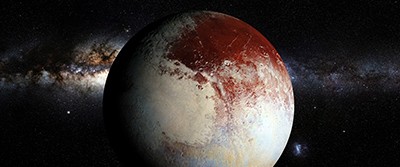Pluto’s Icy Volcanoes Shed Light on Prelife Chemistry

By Sadie Laurie
As reported in Science Advances , recent studies of images of Pluto revealed that ammonia and organic chemicals may have been spread across the dwarf planet’s surface by icy volcanic eruptions, shedding new light on these important chemical precursors to life.
The images of the dwarf planet were taken by the New Horizons spacecraft that traveled past Pluto in July 2015. Upon first inspection of the images, researchers noted different types of ice overlaying a bedrock of incredibly dense water ice that forms because of the dwarf planet’s frigid temperatures.
Planetary scientist Dale Cruikshank and colleagues at the NASA Ames Research Center in Moffett Field, CA, further analyzed the wavelengths of light in the images that can act as signatures of a variety of chemical compounds. They found signs of ammonia in the exposed water ice.
Because ammonia is fragile and breaks down in 400,000 to a billion years, it had to have been put there recently, according to Cruikshank. He and his team saw it clustered around a large crack in Pluto’s surface called Virgil Fossa. They think organic-rich liquid water and ammonia erupted from a cryovolcano that caused the fissure near the dwarf planet’s famous heart-shaped feature called Sputnik Planum.
“This was a huge surprise to all of us about Pluto,” said Cruikshank. “It means there are lots of surprises waiting to be uncovered in that part of the solar system.”
Some scientists believe there is an ocean of salt water beneath Sputnik Planum, according to Science News Online. The presence of ammonia could help explain how the water could stay in a liquid form so far from the sun.
It acts as an antifreeze that can lower water’s freezing point by 100°C, according to planetary scientist Steven Desch of Arizona State University in Tempe. Although he wasn’t involved with the study, he’s not surprised by its results.
“We have thought for a long time that … Pluto … should have cryovolcanic activity,” he said. “It’s kind of a mystery why we don’t see more indications of it.”
Cruikshank believes that one or more eruptions spread ammoniated ice as far as 200 kilometers from the fissure. In addition to ammonia, he and his team observed a red material across the landscape that could also have been spewed by the cryovolcano. They think it could be a complex organic material that they have seen on Pluto before.
The team originally thought the organic molecules were formed on the dwarf planet’s surface or in the atmosphere — now the images suggest they could exist in Pluto’s subsurface ocean.
As reported by Cruikshank and colleagues in Astrobiology, you can create molecules that are important to life — including the nucleobases that make up DNA and RNA — by irradiating ice rich in ammonia and organics in the lab. This gives scientists a new way of thinking about the chemical precursors to life.
"It’s telling you pretty much that you don’t need to be around a star for interesting things to happen,” said astrobiologist Marc Neveu of NASA Goddard Space Flight Center in Greenbelt, MD. “If it happens deep inside Pluto, in the dark, with a very cold surface ... this prebiotic, prelife chemistry can happen anywhere."
Discussion Questions
- What are chemical precursors to life?
- Do you think they could exist on Pluto?
- Do you think there could be an ocean under the icy surface of Pluto?
Vocabulary
- Cryovolcano
- Fissure
- Water Ice

